
Yesterday, the Australian Bureau of Statistics (ABS) released its long-term population projections, which provide population projections under three scenarios:
- High growth scenario (Series A), which assumes Australia’s future total fertility rates will reach 2.0 babies per woman by 2026 and then remain constant, life expectancy at birth will continue to increase until 2061 (reaching 92.1 years for males and 93.6 years for females), and NOM will reach 280,000 by 2021 and then remain constant.
- Medium growth scenario (Series B), which assumes Australia’s future total fertility rates will decrease to 1.8 babies per woman by 2026 and then remain constant, life expectancy at birth will continue to increase each year until 2061, though at a declining rate (reaching 85.2 years for males and 88.3 years for females), and NOM will remain constant at 240,000 per year throughout the projection period.
- Low growth scenario (Series C), which assumes Australia’s future total fertility rates will decrease to 1.6 babies per woman by 2026 and then remain constant, life expectancy at birth will continue to increase each year until 2061, though at a declining rate (reaching 85.2 years for males and 88.3 years for females), and NOM will reach 200,000 per year by 2021 and then remain constant.
The assumptions underpinning these projections are provided in the table below:

Below are some charts summarising the data.
First, consider Australia’s projected population growth under these three scenarios:
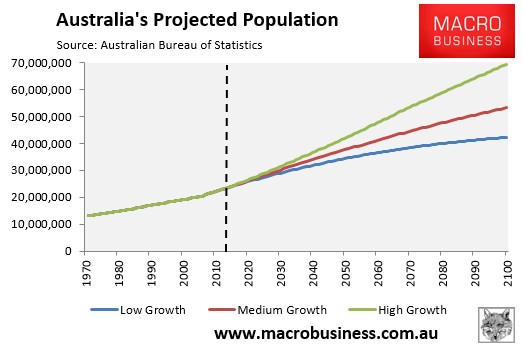
By the year 2100, Australia’s population would be 83% larger under the Low Growth Scenario, 131% larger under the Medium Growth Scenario, and 201% larger under the High Growth Scenario.
Moreover, Australia’s population is projected to age rapidly under all three scenarios.
First, consider the share of Australia’s population aged 65+ and 80+ under the Low Growth Scenario:
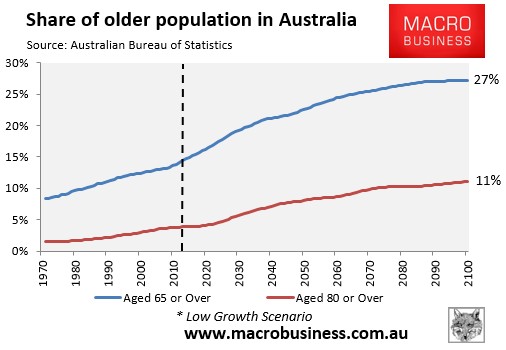
Now consider population ageing under the Medium Growth Scenario:
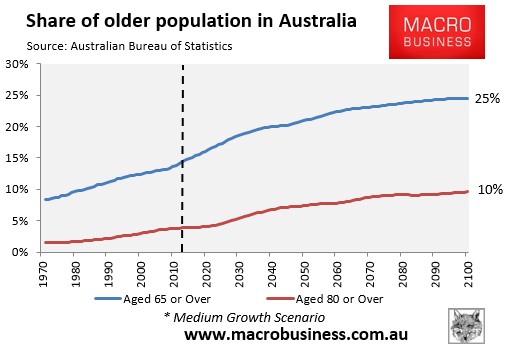
And now the High Growth Scenario:
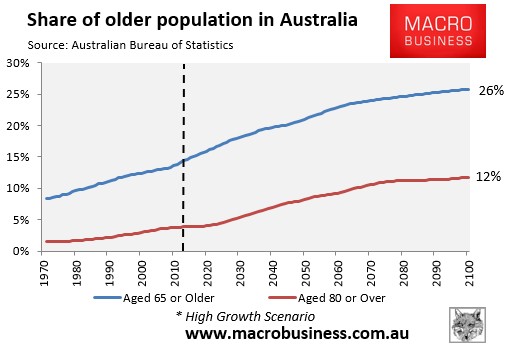
Incredibly, by the year 2100, Australia’s older population – those aged over 65 years of age – is projected to reach 18 million under the High Growth Scenario, which isn’t that much smaller than Australia’s current population!
Below I have also converted the ABS data under the three scenarios into Dependency Ratios – defined as the ratio of the non-working population, both children (<20 years old) and the elderly (over 65 years old), to the working age population.
First, consider Australia’s dependency ratios under the Low Growth Scenario:
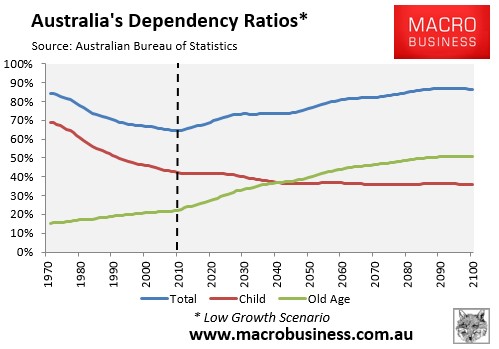
As you can see, Australia’s total dependency ratio is projected to increase sharply, from around 66% currently to 87% by the end of the century. This increase in the dependency ratio is driven by a steady increase in the proportion of the population aged over 65 (the current standard ‘retirement age’), offset partly by a reduction in the child dependency ratio (i.e. those aged under 20 years of age).
Now consider the projected dependency ratios under the Medium Growth Scenario:
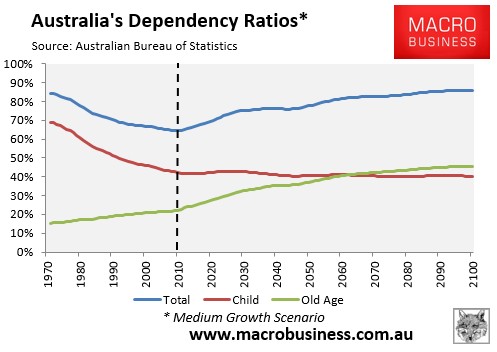
There is minimal difference under this scenario, with the total dependency ratio increasing to just under 86% by 2100.
Finally, consider Australia’s projected dependency ratio under the High Growth Scenario:
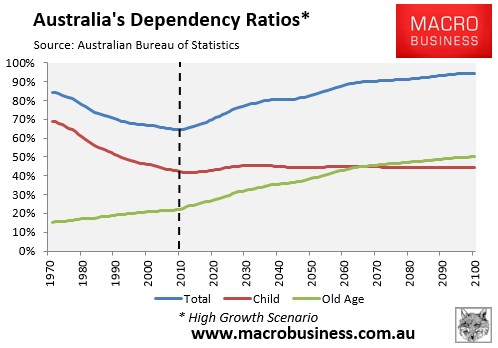
Amazingly, the high growth scenario provides the worst outcome, with Australia’s total dependency ratio projected to increase to nearly 95% by the end of the century. Although the old age dependency ratio is much the same as under the low growth scenario, the proportion of younger people is significantly higher.
Finally, below are the total dependency ratios charted together on a single graph:
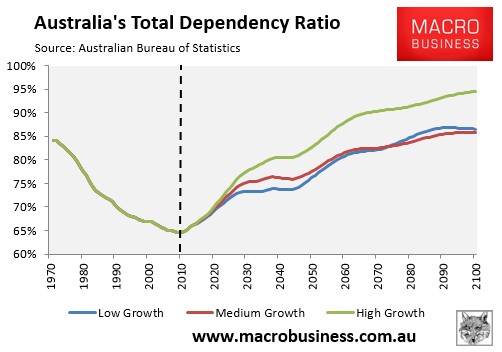
As well as the ratio of workers per dependent under the three scenarios:
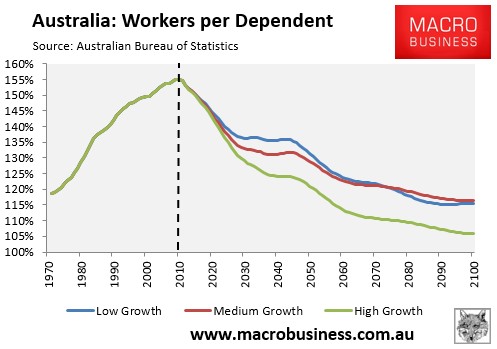
Based on the ABS’ projections, the calls for Australia to increase its immigration and/or birth rates in order to mitigate the impacts of an ageing population appear to be misguided. And this view is supported by the Productivity Commission in its submission to the former Minister for Population:
…several studies, including some undertaken by the Commission, indicate that policy-induced changes to Australia’s population are unlikely to significantly affect the ageing trends.
Improvements in longevity are the major cause of population ageing over the long run. In recent projections, Commission researchers estimated that an increase in the long-run total fertility rate from 1.85 to 2.10 births per woman — even if it could be achieved — would be associated with only a 1.1 percentage point reduction in the proportion of people aged over 65 by 2051.
Similarly, substantial increases in the level of net overseas migration would have only modest effects on population ageing and the impacts would be temporary, since immigrants themselves age. The Commission has estimated that an increase in annual net migration from 150 000 to 300 000 would lower the proportion of those aged 65 or over by less than 3 percentage points by 2044-45. As an illustration ofthe challenge, the Commission showed that delaying an increase in the dependency ratio by 40 years would require a net migration-to-population ratio of 3 per cent per year, leading to a population of around 85 million by 2044-45.
It follows that, rather than seeking to mitigate the ageing of the population, policy should seek to influence the potential economic and other impacts.
While it is undeniably true that population ageing will have wide ranging impacts on the Australian economy – from reduced consumption expenditure, to slower asset price growth, and reduced government taxation revenue and higher spending on health and aged care – endless population growth and immigration is not a sustainable solution to Australia’s ageing ‘problems’.
In the long-run, the only way to mitigate the effects of population ageing is through: (1) greater productivity growth; (2) higher workforce participation; (3) tightening eligibility requirements for entitlements, such as the aged pension, aged care, and subsidised health care; and (4) reducing superannuation concessions for higher income earners.
Think about these facts the next time a population booster argues for a higher immigration intake to alleviate pressures arising from an ageing population.

